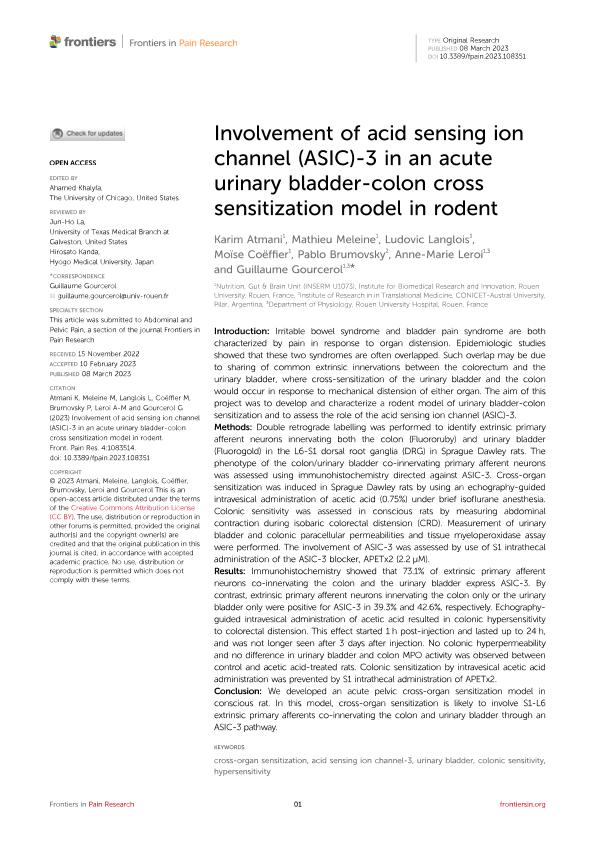Artículo
Involvement of acid sensing ion channel (ASIC)-3 in an acute urinary bladder-colon cross sensitization model in rodent
Atmani, Karim; Meleine, Mathieu; Langlois, Ludovic; Coëffier, Moïse; Brumovsky, Pablo Rodolfo ; Leroi, Anne Marie; Gourcerol, Guillaume
; Leroi, Anne Marie; Gourcerol, Guillaume
 ; Leroi, Anne Marie; Gourcerol, Guillaume
; Leroi, Anne Marie; Gourcerol, Guillaume
Fecha de publicación:
03/2023
Editorial:
Frontiers Media
Revista:
Frontiers in Pain Research
e-ISSN:
2673-561X
Idioma:
Inglés
Tipo de recurso:
Artículo publicado
Clasificación temática:
Resumen
Introduction: Irritable bowel syndrome and bladder pain syndrome are both characterized by pain in response to organ distension. Epidemiologic studies showed that these two syndromes are often overlapped. Such overlap may be due to sharing of common extrinsic innervations between the colorectum and the urinary bladder, where cross-sensitization of the urinary bladder and the colon would occur in response to mechanical distension of either organ. The aim of this project was to develop and characterize a rodent model of urinary bladder-colon sensitization and to assess the role of the acid sensing ion channel (ASIC)-3.Methods: Double retrograde labelling was performed to identify extrinsic primary afferent neurons innervating both the colon (Fluororuby) and urinary bladder (Fluorogold) in the L6-S1 dorsal root ganglia (DRG) in Sprague Dawley rats. The phenotype of the colon/urinary bladder co-innervating primary afferent neurons was assessed using immunohistochemistry directed against ASIC-3. Cross-organ sensitization was induced in Sprague Dawley rats by using an echography-guided intravesical administration of acetic acid (0.75%) under brief isoflurane anesthesia. Colonic sensitivity was assessed in conscious rats by measuring abdominal contraction during isobaric colorectal distension (CRD). Measurement of urinary bladder and colonic paracellular permeabilities and tissue myeloperoxidase assay were performed. The involvement of ASIC-3 was assessed by use of S1 intrathecal administration of the ASIC-3 blocker, APETx2 (2.2 µM).Results: Immunohistochemistry showed that 73.1% of extrinsic primary afferent neurons co-innervating the colon and the urinary bladder express ASIC-3. By contrast, extrinsic primary afferent neurons innervating the colon only or the urinary bladder only were positive for ASIC-3 in 39.3% and 42.6%, respectively. Echography-guided intravesical administration of acetic acid resulted in colonic hypersensitivity to colorectal distension. This effect started 1 h post-injection and lasted up to 24 h, and was not longer seen after 3 days after injection. No colonic hyperpermeability and no difference in urinary bladder and colon MPO activity was observed between control and acetic acid-treated rats. Colonic sensitization by intravesical acetic acid administration was prevented by S1 intrathecal administration of APETx2.Conclusion: We developed an acute pelvic cross-organ sensitization model in conscious rat. In this model, cross-organ sensitization is likely to involve S1-L6 extrinsic primary afferents co-innervating the colon and urinary bladder through an ASIC-3 pathway.
Archivos asociados
Licencia
Identificadores
Colecciones
Articulos(IIMT)
Articulos de INSTITUTO DE INVESTIGACIONES EN MEDICINA TRASLACIONAL
Articulos de INSTITUTO DE INVESTIGACIONES EN MEDICINA TRASLACIONAL
Citación
Atmani, Karim; Meleine, Mathieu; Langlois, Ludovic; Coëffier, Moïse; Brumovsky, Pablo Rodolfo; et al.; Involvement of acid sensing ion channel (ASIC)-3 in an acute urinary bladder-colon cross sensitization model in rodent; Frontiers Media; Frontiers in Pain Research; 4; 1083514; 3-2023; 1-10
Compartir
Altmétricas



